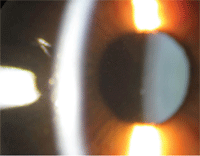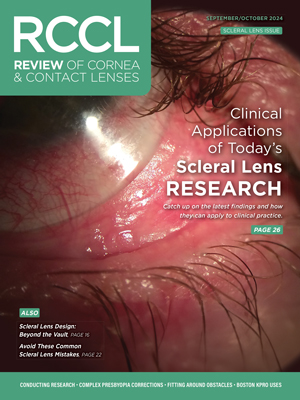 Postoperative anterior chamber inflammation is an expected and usually benign consequence of ocular surgery. A routine course of topical corticosteroids normally suffices to quell the likely cells and flare. However, situations do exist in which a patient is a known steroid responder or is sensitive to preserved solutions, and is consequently in need of an alternative treatment. The solution, until now, was to have a compounding pharmacy specially formulate a preservative-free steroid drop or ointment, which could be cost-prohibitive for many patients.
Postoperative anterior chamber inflammation is an expected and usually benign consequence of ocular surgery. A routine course of topical corticosteroids normally suffices to quell the likely cells and flare. However, situations do exist in which a patient is a known steroid responder or is sensitive to preserved solutions, and is consequently in need of an alternative treatment. The solution, until now, was to have a compounding pharmacy specially formulate a preservative-free steroid drop or ointment, which could be cost-prohibitive for many patients.
Introducing Lotemax
Lotemax ointment (loteprednol etabonate 0.5%, Bausch + Lomb) is indicated to treat inflammation and pain following ocular surgery. It is the first preservative-free topical ophthalmic steroid preparation in the United States and is the first monotherapy steroid ointment brought to the U.S. market in 20 years.
Lotemax ointment is available in a 3.5mg tube and is indicated for usage q.i.d., beginning 24 hours after ocular surgery and lasting for up to two weeks. Patients should be advised not to wear contact lenses during this time. It is contraindicated in children following ocular surgery, as it may interfere with amblyopia treatment.
Loteprednol etabonate (LE) ophthalmic suspension has been in common use for many years and is indicated for the treatment of steroid-responsive conditions of the palpebral bulbar conjunctiva, cornea and anterior segment of the globe, as well as inflammation following ocular surgery.1 Compared to dexamethasone or prednisolone acetate, it has a lower propensity for increased intraocular pressure (IOP).2,3
Having an ointment preparation will provide practitioners with a choice of dosage forms when treating postoperative inflammation.
Safety Trials
The safety and efficacy of LE 0.5% ointment to treat inflammation and pain following cataract surgery was assessed in two Phase 3, randomized, double-masked, parallel group vehicle-controlled studies at 33 centers in the United States.4 The 805 patients were randomized: 404 received LE ointment and 401 received vehicle (mineral oil and white petroleum) treatments. Only patients over the age of 18 with negative pregnancy tests and an anterior chamber inflammation score of less than three on the first postoperative day were eligible.
The study period lasted approximately four weeks and required seven total visits. Cataract surgery was performed on the second visit, which was scheduled within 14 days of the initial visit. All eligible patients received either the LE ointment or vehicle, to be used four times a day by instilling a half-inch ribbon of drug into the inferior cul-de-sac for 14 days. They were seen on postoperative days one, three, eight, 15 and 18.
The primary efficacy endpoints of this study were the proportion of patients with complete resolution of anterior chamber inflammation and no pain (Grade 0) on the fifth visit, postoperative day eight. Safety endpoints included incidence of adverse events, change in baseline IOP and visual acuity, abnormal slit lamp findings or subjective symptoms.

Anterior segment inflammation.
Only 12 patients (1.5%) discontinued the study—four LE ointment patients for failure to follow procedure, to follow up or “other” reasons, and eight vehicle patients due to patient withdrawal, adverse events and investigator decision.
The findings included:
Complete resolution of anterior chamber inflammation was observed in 27.7% of LE ointment patients, as compared to 12.5% of vehicle patients (p<0.0001).
The LE ointment patients also had a statistically significantly greater rate of Grade 0 pain (75.5%) vs. the vehicle patients (43.1%).
Mean baseline IOP was similar between the groups on the first postoperative visit and was constantly lower than the baseline for both groups at subsequent visits.
Three patients in the LE ointment group and one patient in the vehicle group experienced an increased IOP (>10mm Hg from baseline) throughout the study.
Fewer adverse events were reported in the LE ointment group (47.2%) vs. the vehicle group (78.0%), which was also statistically significant. These included anterior chamber inflammation, photophobia, corneal edema, conjunctival hyperemia and pain. However, these reactions can also be attributed to the surgical procedure itself.
Lotemax ointment provides eye care practitioners with a medication that has a proven track record that we can be confident in using on our post-surgical patients. For these reasons, it is an important addition to our pharmaceutical toolbox.
1. Bausch + Lomb. Lotemax package insert.
2. Holland EJ, Bartlett JD, Paterno MR, et al. Effects of loteprednol/tobramycin versus dexamethasone/tobramycin on intraocular pressure in healthy volunteers. Cornea. 2008 Jan;27(1):50-5.
3. Bartlett JD, Horwitz B, Laibovitz R, Howes JF. Intraocular pressure response to loteprednol etabonate in known steroid responders. J Ocul Pharmacol. 1993 Summer;9(2):157-65.
4. Comstock TL, Paterno MR, Singh A, et al. Safety and efficacy of loteprednol etabonate ophthalmic ointment 0.5% for the treatment of inflammation and pain following cataract surgery. Clin Ophthalmol. 2011 Feb;5:177-86.


